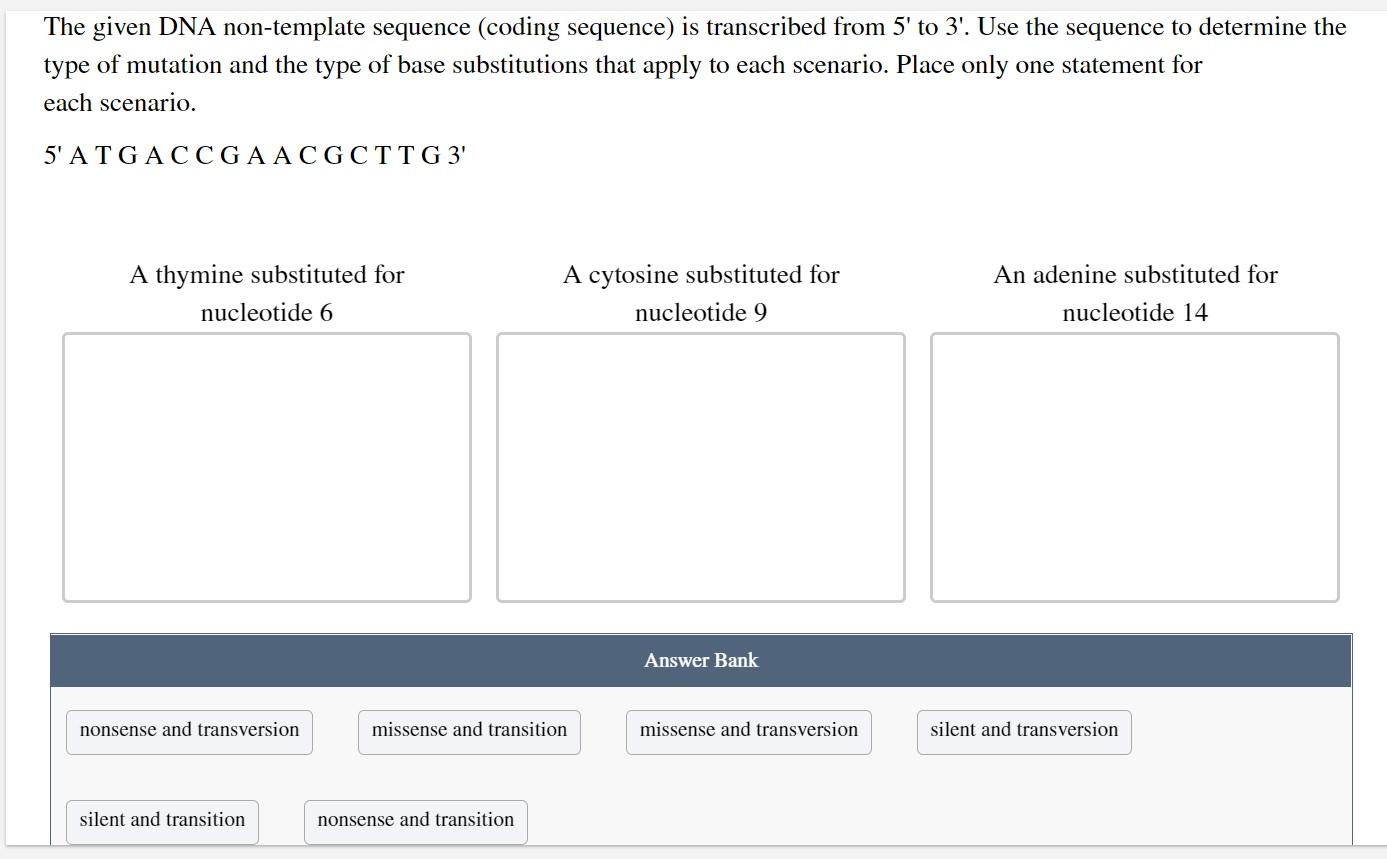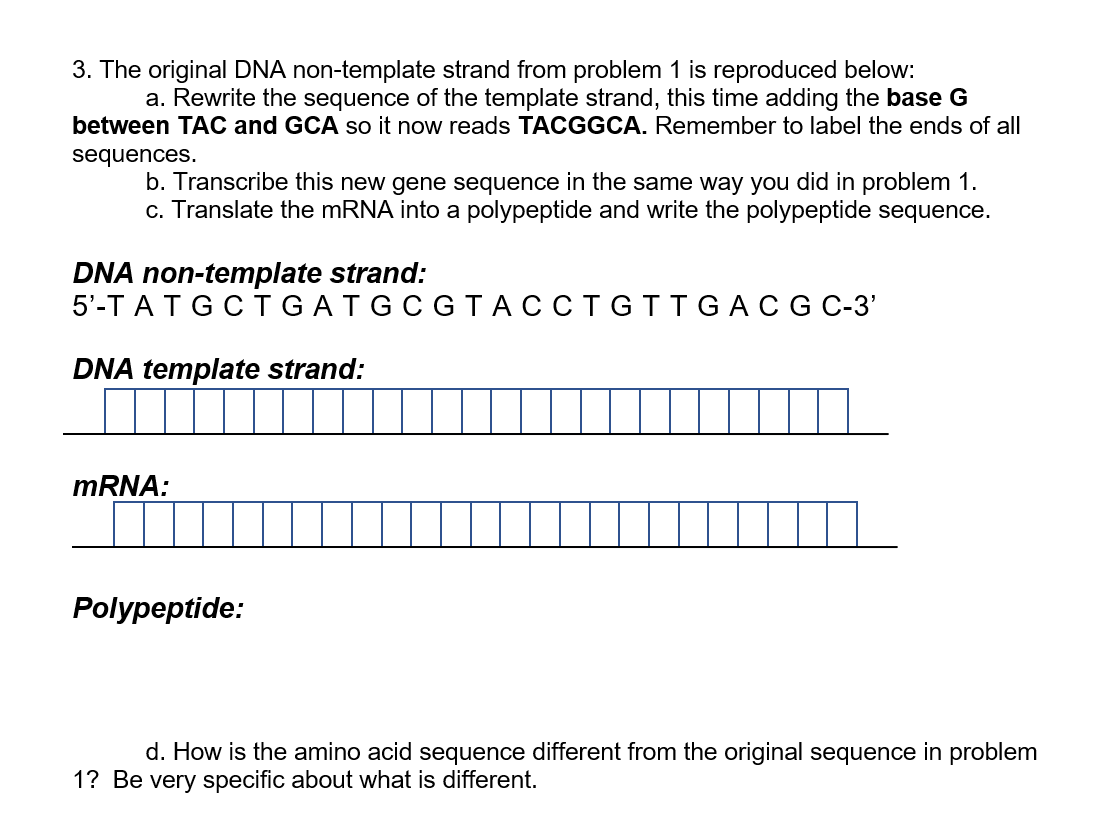The Given Dna Non Template Sequence
The Given Dna Non Template Sequence - The given dna non‑template sequence (coding sequence) is transcribed from 3' to 5'. The given dna non‑template sequence (coding sequence) is transcribed from 5' to 3'. Use the sequence to determine the type of mutation and. The given dna non template sequence (coding sequence) is transcribed from 5' to 3'. The given dna non template sequence (coding sequence) is transcribed from 3' to 5'. Use the sequence to determine the type of mutation and. The given dna non‑template sequence (coding sequence) is transcribed from 5' to 3'. Use the sequence to determine the type of mutation and. Use the sequence to determine the type. The given dna non‑template sequence (coding sequence) is transcribed from 5' to 3'.
Solved The given DNA nontemplate sequence (coding sequence)
The answer is simple : The given dna non‑template sequence (coding sequence) is transcribed from 5' to 3'. The given dna non‑template sequence (coding sequence) is transcribed from 5' to 3'. The given dna non template sequence (coding sequence) is transcribed from 3' to 5'. The given dna non‑template sequence (coding sequence) is transcribed from 3' to 5'.
Non Template Dna Strand
The answer is simple : Use the sequence to determine the type of mutation and. The given dna non template sequence (coding sequence) is transcribed from 5' to 3'. Use the sequence to determine the type of mutation and. The given dna non template sequence (coding sequence) is transcribed from 3' to 5'.
Solved The given DNA nontemplate sequence (coding sequence)
The given dna non template sequence (coding sequence) is transcribed from 5' to 3'. To determine the type of mutation and base. Use the sequence to determine the type of mutation and. The given dna non‑template sequence (coding sequence) is transcribed from 3' to 5'. The given dna non‑template sequence (coding sequence) is transcribed from 5' to 3'.
Solved The given DNA nontemplate sequence (coding sequence)
Use the sequence to determine the type of mutation and. Use the sequence to determine the type. The given dna non template sequence (coding sequence) is transcribed from 3' to 5'. To determine the type of mutation and base. Use the sequence to determine the type of mutation and the type of base substitutions that apply to.
SOLVED The given DNA nontemplate sequence (coding sequence) is transcribed from 5' to 3'. Use
The given dna non template sequence (coding sequence) is transcribed from 3' to 5'. Use the sequence to determine the type of mutation and. The given dna non‑template sequence (coding sequence) is transcribed from 5' to 3'. The given dna non template sequence (coding sequence) is transcribed from 5' to 3'. Use the sequence to determine the type of mutation.
The given DNA nontemplate sequence (coding sequence)
Use the sequence to determine the type of mutation and. Use the sequence to determine the type of mutation and. The given dna non‑template sequence (coding sequence) is transcribed from 5' to 3'. Use the sequence to determine the type of mutation and the type of base substitutions that apply to. The given dna non‑template sequence (coding sequence) is transcribed.
Solved 1. For parts a and b below, remember to label the
Use the sequence to determine the type of mutation and the type of base substitutions that apply to. Use the sequence to determine the type of mutation and. The given dna non template sequence (coding sequence) is transcribed from 3' to 5'. Use the sequence to determine the type of mutation and. The given dna non template sequence (coding sequence).
Solved Given the following DNA nontemplate sequence,
The given dna non‑template sequence (coding sequence) is transcribed from 5' to 3'. Use the sequence to determine the type of mutation and. The answer is simple : Use the sequence to determine the type. Use the sequence to determine the type of mutation and.
The given dna non template sequence (coding sequence) is transcribed from 3' to 5'. The given dna non template sequence (coding sequence) is transcribed from 5' to 3'. Use the sequence to determine the type of mutation and. To determine the type of mutation and base. Use the sequence to determine the type. The given dna non‑template sequence (coding sequence) is transcribed from 3' to 5'. Use the sequence to determine the type of mutation and. The given dna non‑template sequence (coding sequence) is transcribed from 5' to 3'. Use the sequence to determine the type of mutation and the type of base substitutions that apply to. The answer is simple : The given dna non‑template sequence (coding sequence) is transcribed from 5' to 3'. The given dna non‑template sequence (coding sequence) is transcribed from 5' to 3'. Use the sequence to determine the type of mutation and. Use the sequence to determine the type of mutation and.
Use The Sequence To Determine The Type.
Use the sequence to determine the type of mutation and. The given dna non‑template sequence (coding sequence) is transcribed from 3' to 5'. The given dna non template sequence (coding sequence) is transcribed from 3' to 5'. Use the sequence to determine the type of mutation and the type of base substitutions that apply to.
The Given Dna Non‑Template Sequence (Coding Sequence) Is Transcribed From 5' To 3'.
To determine the type of mutation and base. Use the sequence to determine the type of mutation and. The answer is simple : The given dna non template sequence (coding sequence) is transcribed from 5' to 3'.
The Given Dna Non‑Template Sequence (Coding Sequence) Is Transcribed From 5' To 3'.
Use the sequence to determine the type of mutation and. The given dna non‑template sequence (coding sequence) is transcribed from 5' to 3'. Use the sequence to determine the type of mutation and.






